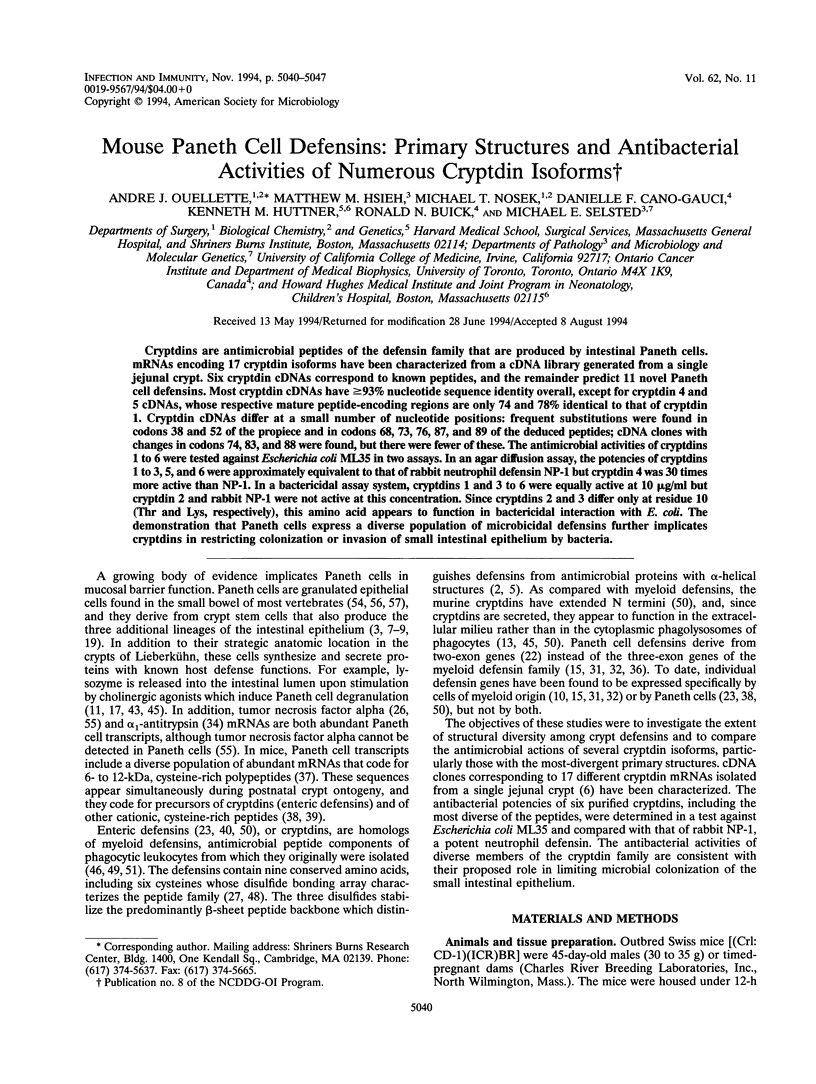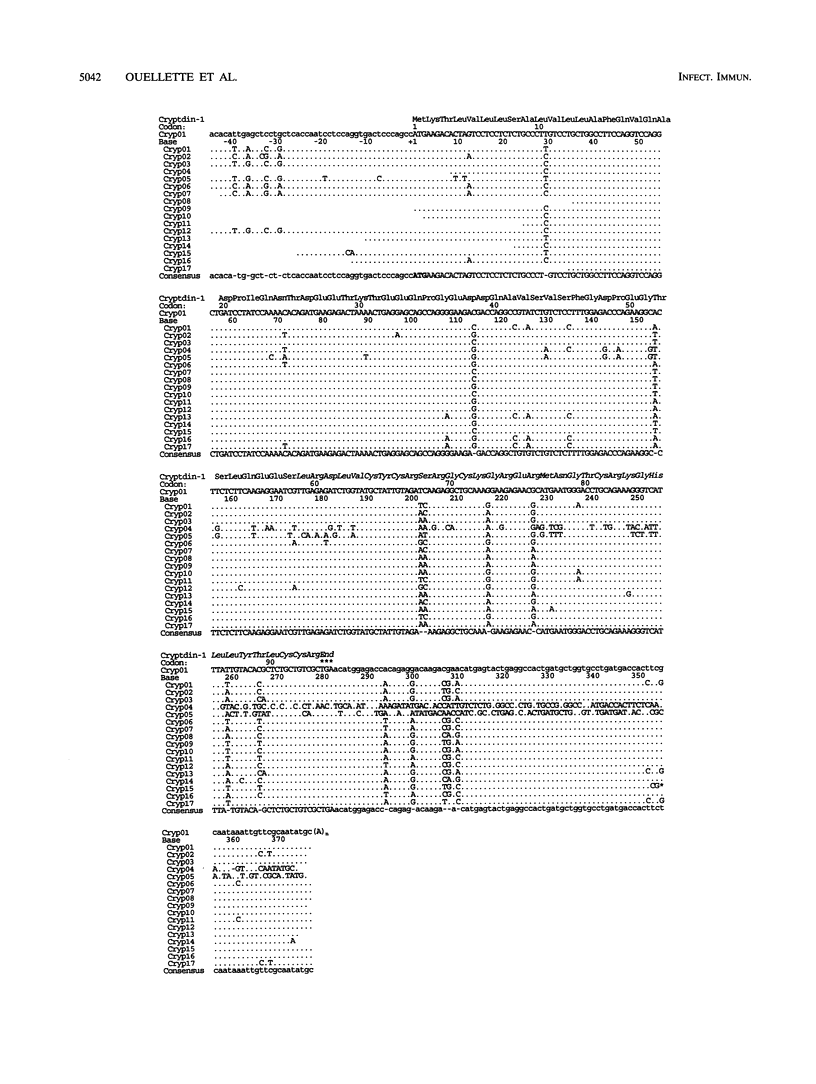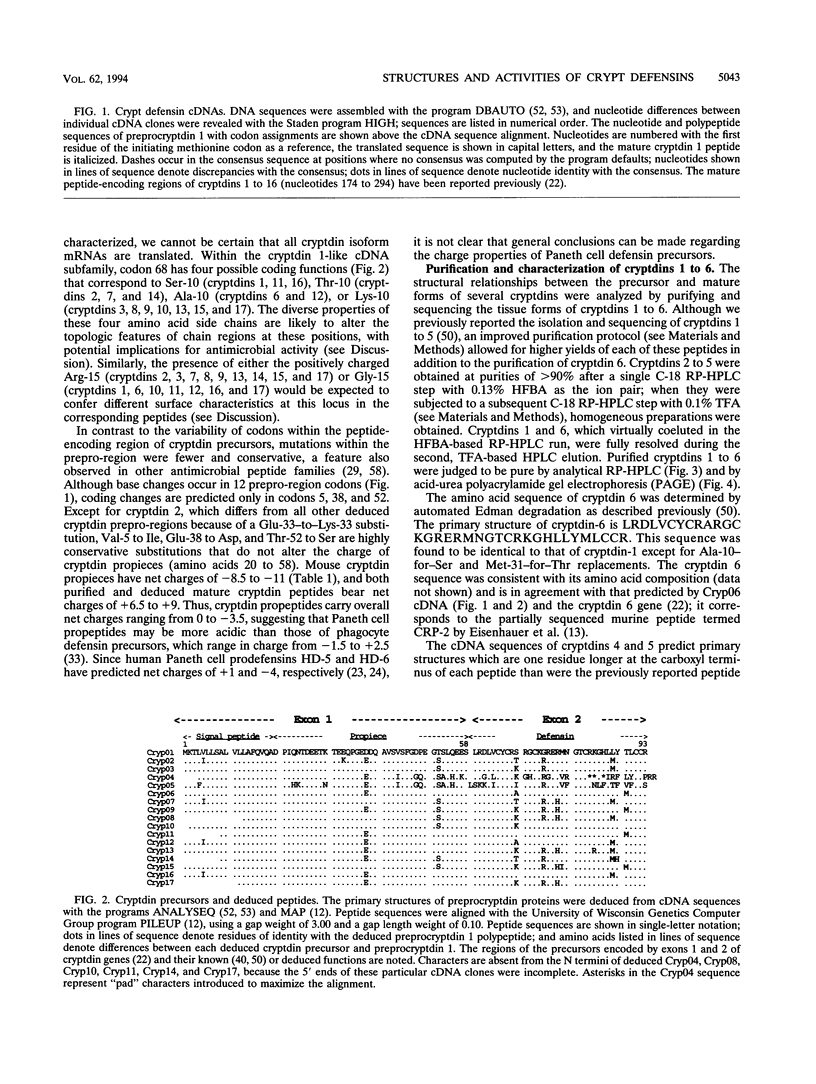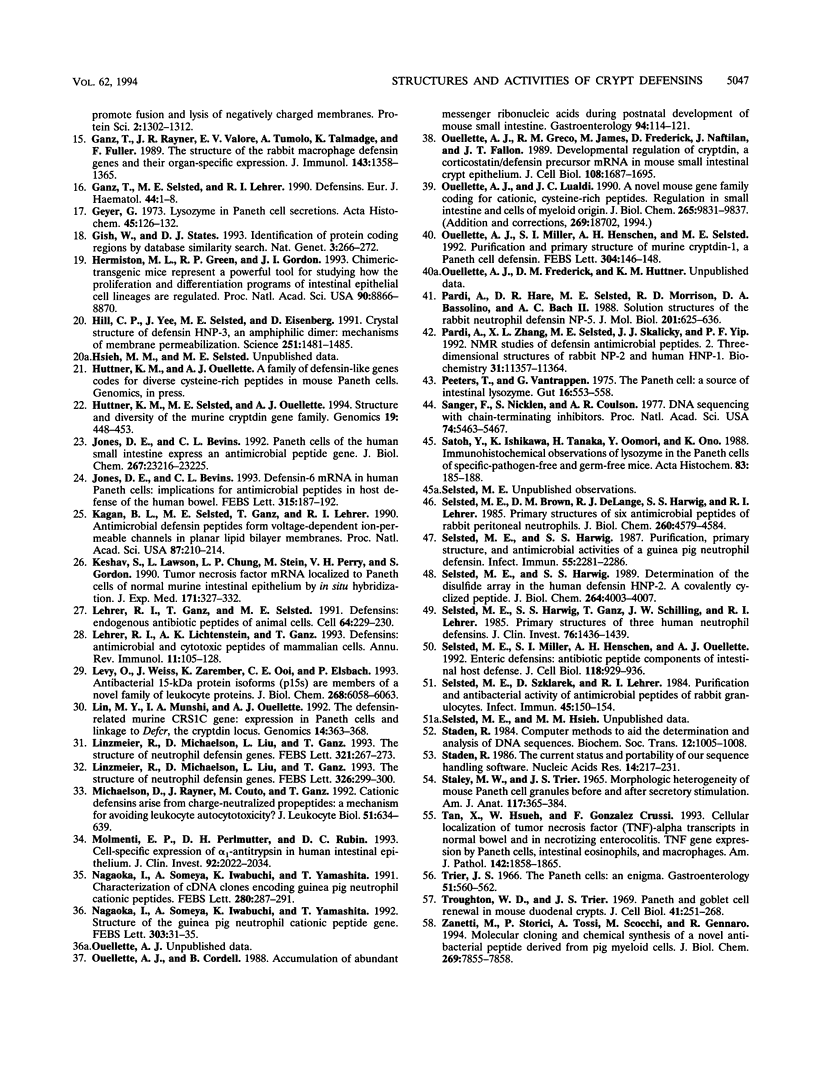Abstract
Cryptdins are antimicrobial peptides of the defensin family that are produced by intestinal Paneth cells. mRNAs encoding 17 cryptdin isoforms have been characterized from a cDNA library generated from a single jejunal crypt. Six cryptdin cDNAs correspond to known peptides, and the remainder predict 11 novel Paneth cell defensins. Most cryptdin cDNAs have > or = 93% nucleotide sequence identity overall, except for cryptdin 4 and 5 cDNAs, whose respective mature peptide-encoding regions are only 74 and 78% identical to that of cryptdin 1. Cryptdin cDNAs differ at a small number of nucleotide positions: frequent substitutions were found in codons 38 and 52 of the propiece and in codons 68, 73, 76, 87, and 89 of the deduced peptides; cDNA clones with changes in codons 74, 83, and 88 were found, but there were fewer of these. The antimicrobial activities of cryptdins 1 to 6 were tested against Escherichia coli ML35 in two assays. In an agar diffusion assay, the potencies of cryptdins 1 to 3, 5, and 6 were approximately equivalent to that of rabbit neutrophil defensin NP-1 but cryptdin 4 was 30 times more active than NP-1. In a bactericidal assay system, cryptdins 1 and 3 to 6 were equally active at 10 micrograms/ml but cryptdin 2 and rabbit NP-1 were not active at this concentration. Since cryptdins 2 and 3 differ only at residue 10 (Thr and Lys, respectively), this amino acid appears to function in bactericidal interaction with E. coli. The demonstration that Paneth cells express a diverse population of microbicidal defensins further implicates cryptdins in restricting colonization or invasion of small intestinal epithelium by bacteria.
Full text
PDF







Images in this article
Selected References
These references are in PubMed. This may not be the complete list of references from this article.
- Altschul S. F., Gish W., Miller W., Myers E. W., Lipman D. J. Basic local alignment search tool. J Mol Biol. 1990 Oct 5;215(3):403–410. doi: 10.1016/S0022-2836(05)80360-2. [DOI] [PubMed] [Google Scholar]
- Bevins C. L., Zasloff M. Peptides from frog skin. Annu Rev Biochem. 1990;59:395–414. doi: 10.1146/annurev.bi.59.070190.002143. [DOI] [PubMed] [Google Scholar]
- Bjerknes M., Cheng H. Methods for the isolation of intact epithelium from the mouse intestine. Anat Rec. 1981 Apr;199(4):565–574. doi: 10.1002/ar.1091990412. [DOI] [PubMed] [Google Scholar]
- Bjerknes M., Cheng H. The stem-cell zone of the small intestinal epithelium. I. Evidence from Paneth cells in the adult mouse. Am J Anat. 1981 Jan;160(1):51–63. doi: 10.1002/aja.1001600105. [DOI] [PubMed] [Google Scholar]
- Boman H. G. Antibacterial peptides: key components needed in immunity. Cell. 1991 Apr 19;65(2):205–207. doi: 10.1016/0092-8674(91)90154-q. [DOI] [PubMed] [Google Scholar]
- Cano-Gauci D. F., Lualdi J. C., Ouellette A. J., Brady G., Iscove N. N., Buick R. N. In vitro cDNA amplification from individual intestinal crypts: a novel approach to the study of differential gene expression along the crypt-villus axis. Exp Cell Res. 1993 Oct;208(2):344–349. doi: 10.1006/excr.1993.1255. [DOI] [PubMed] [Google Scholar]
- Cheng H., Leblond C. P. Origin, differentiation and renewal of the four main epithelial cell types in the mouse small intestine. V. Unitarian Theory of the origin of the four epithelial cell types. Am J Anat. 1974 Dec;141(4):537–561. doi: 10.1002/aja.1001410407. [DOI] [PubMed] [Google Scholar]
- Cheng H. Origin, differentiation and renewal of the four main epithelial cell types in the mouse small intestine. IV. Paneth cells. Am J Anat. 1974 Dec;141(4):521–535. doi: 10.1002/aja.1001410406. [DOI] [PubMed] [Google Scholar]
- Cohn S. M., Roth K. A., Birkenmeier E. H., Gordon J. I. Temporal and spatial patterns of transgene expression in aging adult mice provide insights about the origins, organization, and differentiation of the intestinal epithelium. Proc Natl Acad Sci U S A. 1991 Feb 1;88(3):1034–1038. doi: 10.1073/pnas.88.3.1034. [DOI] [PMC free article] [PubMed] [Google Scholar]
- Daher K. A., Lehrer R. I., Ganz T., Kronenberg M. Isolation and characterization of human defensin cDNA clones. Proc Natl Acad Sci U S A. 1988 Oct;85(19):7327–7331. doi: 10.1073/pnas.85.19.7327. [DOI] [PMC free article] [PubMed] [Google Scholar]
- Deckx R. J., Vantrappen G. R., Parein M. M. Localization of lysozyme activity in a Paneth cell granule fraction. Biochim Biophys Acta. 1967 May 16;139(1):204–207. doi: 10.1016/0005-2744(67)90136-2. [DOI] [PubMed] [Google Scholar]
- Devereux J., Haeberli P., Smithies O. A comprehensive set of sequence analysis programs for the VAX. Nucleic Acids Res. 1984 Jan 11;12(1 Pt 1):387–395. doi: 10.1093/nar/12.1part1.387. [DOI] [PMC free article] [PubMed] [Google Scholar]
- Eisenhauer P. B., Harwig S. S., Lehrer R. I. Cryptdins: antimicrobial defensins of the murine small intestine. Infect Immun. 1992 Sep;60(9):3556–3565. doi: 10.1128/iai.60.9.3556-3565.1992. [DOI] [PMC free article] [PubMed] [Google Scholar]
- Fujii G., Selsted M. E., Eisenberg D. Defensins promote fusion and lysis of negatively charged membranes. Protein Sci. 1993 Aug;2(8):1301–1312. doi: 10.1002/pro.5560020813. [DOI] [PMC free article] [PubMed] [Google Scholar]
- Ganz T., Rayner J. R., Valore E. V., Tumolo A., Talmadge K., Fuller F. The structure of the rabbit macrophage defensin genes and their organ-specific expression. J Immunol. 1989 Aug 15;143(4):1358–1365. [PubMed] [Google Scholar]
- Geyer G. Lysozyme in Paneth cell secretions. Acta Histochem. 1973;45(1):126–132. [PubMed] [Google Scholar]
- Gish W., States D. J. Identification of protein coding regions by database similarity search. Nat Genet. 1993 Mar;3(3):266–272. doi: 10.1038/ng0393-266. [DOI] [PubMed] [Google Scholar]
- Hermiston M. L., Green R. P., Gordon J. I. Chimeric-transgenic mice represent a powerful tool for studying how the proliferation and differentiation programs of intestinal epithelial cell lineages are regulated. Proc Natl Acad Sci U S A. 1993 Oct 1;90(19):8866–8870. doi: 10.1073/pnas.90.19.8866. [DOI] [PMC free article] [PubMed] [Google Scholar]
- Hill C. P., Yee J., Selsted M. E., Eisenberg D. Crystal structure of defensin HNP-3, an amphiphilic dimer: mechanisms of membrane permeabilization. Science. 1991 Mar 22;251(5000):1481–1485. doi: 10.1126/science.2006422. [DOI] [PubMed] [Google Scholar]
- Huttner K. M., Selsted M. E., Ouellette A. J. Structure and diversity of the murine cryptdin gene family. Genomics. 1994 Feb;19(3):448–453. doi: 10.1006/geno.1994.1093. [DOI] [PubMed] [Google Scholar]
- Jones D. E., Bevins C. L. Defensin-6 mRNA in human Paneth cells: implications for antimicrobial peptides in host defense of the human bowel. FEBS Lett. 1993 Jan 4;315(2):187–192. doi: 10.1016/0014-5793(93)81160-2. [DOI] [PubMed] [Google Scholar]
- Jones D. E., Bevins C. L. Paneth cells of the human small intestine express an antimicrobial peptide gene. J Biol Chem. 1992 Nov 15;267(32):23216–23225. [PubMed] [Google Scholar]
- Kagan B. L., Selsted M. E., Ganz T., Lehrer R. I. Antimicrobial defensin peptides form voltage-dependent ion-permeable channels in planar lipid bilayer membranes. Proc Natl Acad Sci U S A. 1990 Jan;87(1):210–214. doi: 10.1073/pnas.87.1.210. [DOI] [PMC free article] [PubMed] [Google Scholar]
- Keshav S., Lawson L., Chung L. P., Stein M., Perry V. H., Gordon S. Tumor necrosis factor mRNA localized to Paneth cells of normal murine intestinal epithelium by in situ hybridization. J Exp Med. 1990 Jan 1;171(1):327–332. doi: 10.1084/jem.171.1.327. [DOI] [PMC free article] [PubMed] [Google Scholar]
- Lehrer R. I., Ganz T., Selsted M. E. Defensins: endogenous antibiotic peptides of animal cells. Cell. 1991 Jan 25;64(2):229–230. doi: 10.1016/0092-8674(91)90632-9. [DOI] [PubMed] [Google Scholar]
- Lehrer R. I., Lichtenstein A. K., Ganz T. Defensins: antimicrobial and cytotoxic peptides of mammalian cells. Annu Rev Immunol. 1993;11:105–128. doi: 10.1146/annurev.iy.11.040193.000541. [DOI] [PubMed] [Google Scholar]
- Levy O., Weiss J., Zarember K., Ooi C. E., Elsbach P. Antibacterial 15-kDa protein isoforms (p15s) are members of a novel family of leukocyte proteins. J Biol Chem. 1993 Mar 15;268(8):6058–6063. [PubMed] [Google Scholar]
- Lin M. Y., Munshi I. A., Ouellette A. J. The defensin-related murine CRS1C gene: expression in Paneth cells and linkage to Defcr, the cryptdin locus. Genomics. 1992 Oct;14(2):363–368. doi: 10.1016/s0888-7543(05)80227-7. [DOI] [PubMed] [Google Scholar]
- Linzmeier R., Michaelson D., Liu L., Ganz T. The structure of neutrophil defensin genes. FEBS Lett. 1993 Apr 26;321(2-3):267–273. doi: 10.1016/0014-5793(93)80122-b. [DOI] [PubMed] [Google Scholar]
- Linzmeier R., Michaelson D., Liu L., Ganz T. The structure of neutrophil defensin genes. FEBS Lett. 1993 Jul 12;326(1-3):299–300. doi: 10.1016/0014-5793(93)81813-f. [DOI] [PubMed] [Google Scholar]
- Michaelson D., Rayner J., Couto M., Ganz T. Cationic defensins arise from charge-neutralized propeptides: a mechanism for avoiding leukocyte autocytotoxicity? J Leukoc Biol. 1992 Jun;51(6):634–639. doi: 10.1002/jlb.51.6.634. [DOI] [PubMed] [Google Scholar]
- Molmenti E. P., Perlmutter D. H., Rubin D. C. Cell-specific expression of alpha 1-antitrypsin in human intestinal epithelium. J Clin Invest. 1993 Oct;92(4):2022–2034. doi: 10.1172/JCI116797. [DOI] [PMC free article] [PubMed] [Google Scholar]
- Nagaoka I., Someya A., Iwabuchi K., Yamashita T. Characterization of cDNA clones encoding guinea pig neutrophil cationic peptides. FEBS Lett. 1991 Mar 25;280(2):287–291. doi: 10.1016/0014-5793(91)80314-s. [DOI] [PubMed] [Google Scholar]
- Nagaoka I., Someya A., Iwabuchi K., Yamashita T. Structure of the guinea pig neutrophil cationic peptide gene. FEBS Lett. 1992 May 25;303(1):31–35. doi: 10.1016/0014-5793(92)80471-r. [DOI] [PubMed] [Google Scholar]
- Ouellette A. J., Cordell B. Accumulation of abundant messenger ribonucleic acids during postnatal development of mouse small intestine. Gastroenterology. 1988 Jan;94(1):114–121. doi: 10.1016/0016-5085(88)90618-x. [DOI] [PubMed] [Google Scholar]
- Ouellette A. J., Greco R. M., James M., Frederick D., Naftilan J., Fallon J. T. Developmental regulation of cryptdin, a corticostatin/defensin precursor mRNA in mouse small intestinal crypt epithelium. J Cell Biol. 1989 May;108(5):1687–1695. doi: 10.1083/jcb.108.5.1687. [DOI] [PMC free article] [PubMed] [Google Scholar]
- Ouellette A. J., Lualdi J. C. A novel mouse gene family coding for cationic, cysteine-rich peptides. Regulation in small intestine and cells of myeloid origin. J Biol Chem. 1990 Jun 15;265(17):9831–9837. [PubMed] [Google Scholar]
- Ouellette A. J., Miller S. I., Henschen A. H., Selsted M. E. Purification and primary structure of murine cryptdin-1, a Paneth cell defensin. FEBS Lett. 1992 Jun 15;304(2-3):146–148. doi: 10.1016/0014-5793(92)80606-h. [DOI] [PubMed] [Google Scholar]
- Pardi A., Hare D. R., Selsted M. E., Morrison R. D., Bassolino D. A., Bach A. C., 2nd Solution structures of the rabbit neutrophil defensin NP-5. J Mol Biol. 1988 Jun 5;201(3):625–636. doi: 10.1016/0022-2836(88)90643-2. [DOI] [PubMed] [Google Scholar]
- Pardi A., Zhang X. L., Selsted M. E., Skalicky J. J., Yip P. F. NMR studies of defensin antimicrobial peptides. 2. Three-dimensional structures of rabbit NP-2 and human HNP-1. Biochemistry. 1992 Nov 24;31(46):11357–11364. doi: 10.1021/bi00161a013. [DOI] [PubMed] [Google Scholar]
- Peeters T., Vantrappen G. The Paneth cell: a source of intestinal lysozyme. Gut. 1975 Jul;16(7):553–558. doi: 10.1136/gut.16.7.553. [DOI] [PMC free article] [PubMed] [Google Scholar]
- Sanger F., Nicklen S., Coulson A. R. DNA sequencing with chain-terminating inhibitors. Proc Natl Acad Sci U S A. 1977 Dec;74(12):5463–5467. doi: 10.1073/pnas.74.12.5463. [DOI] [PMC free article] [PubMed] [Google Scholar]
- Satoh Y., Ishikawa K., Tanaka H., Oomori Y., Ono K. Immunohistochemical observations of lysozyme in the Paneth cells of specific-pathogen-free and germ-free mice. Acta Histochem. 1988;83(2):185–188. doi: 10.1016/S0065-1281(88)80055-2. [DOI] [PubMed] [Google Scholar]
- Selsted M. E., Brown D. M., DeLange R. J., Harwig S. S., Lehrer R. I. Primary structures of six antimicrobial peptides of rabbit peritoneal neutrophils. J Biol Chem. 1985 Apr 25;260(8):4579–4584. [PubMed] [Google Scholar]
- Selsted M. E., Harwig S. S. Determination of the disulfide array in the human defensin HNP-2. A covalently cyclized peptide. J Biol Chem. 1989 Mar 5;264(7):4003–4007. [PubMed] [Google Scholar]
- Selsted M. E., Harwig S. S., Ganz T., Schilling J. W., Lehrer R. I. Primary structures of three human neutrophil defensins. J Clin Invest. 1985 Oct;76(4):1436–1439. doi: 10.1172/JCI112121. [DOI] [PMC free article] [PubMed] [Google Scholar]
- Selsted M. E., Harwig S. S. Purification, primary structure, and antimicrobial activities of a guinea pig neutrophil defensin. Infect Immun. 1987 Sep;55(9):2281–2286. doi: 10.1128/iai.55.9.2281-2286.1987. [DOI] [PMC free article] [PubMed] [Google Scholar]
- Selsted M. E., Miller S. I., Henschen A. H., Ouellette A. J. Enteric defensins: antibiotic peptide components of intestinal host defense. J Cell Biol. 1992 Aug;118(4):929–936. doi: 10.1083/jcb.118.4.929. [DOI] [PMC free article] [PubMed] [Google Scholar]
- Selsted M. E., Szklarek D., Lehrer R. I. Purification and antibacterial activity of antimicrobial peptides of rabbit granulocytes. Infect Immun. 1984 Jul;45(1):150–154. doi: 10.1128/iai.45.1.150-154.1984. [DOI] [PMC free article] [PubMed] [Google Scholar]
- Staden R. Computer methods to aid the determination and analysis of DNA sequences. Biochem Soc Trans. 1984 Dec;12(6):1005–1008. doi: 10.1042/bst0121005. [DOI] [PubMed] [Google Scholar]
- Staden R. The current status and portability of our sequence handling software. Nucleic Acids Res. 1986 Jan 10;14(1):217–231. doi: 10.1093/nar/14.1.217. [DOI] [PMC free article] [PubMed] [Google Scholar]
- Staley M. W., Trier J. S. Morphologic heterogeneity of mouse Paneth cell granules before and after secretory stimulation. Am J Anat. 1965 Nov;117(3):365–383. doi: 10.1002/aja.1001170305. [DOI] [PubMed] [Google Scholar]
- Tan X., Hsueh W., Gonzalez-Crussi F. Cellular localization of tumor necrosis factor (TNF)-alpha transcripts in normal bowel and in necrotizing enterocolitis. TNF gene expression by Paneth cells, intestinal eosinophils, and macrophages. Am J Pathol. 1993 Jun;142(6):1858–1865. [PMC free article] [PubMed] [Google Scholar]
- Trier J. S. The Paneth cells: an enigma. Gastroenterology. 1966 Oct;51(4):560–562. [PubMed] [Google Scholar]
- Troughton W. D., Trier J. S. Paneth and goblet cell renewal in mouse duodenal crypts. J Cell Biol. 1969 Apr;41(1):251–268. doi: 10.1083/jcb.41.1.251. [DOI] [PMC free article] [PubMed] [Google Scholar]
- Zanetti M., Storici P., Tossi A., Scocchi M., Gennaro R. Molecular cloning and chemical synthesis of a novel antibacterial peptide derived from pig myeloid cells. J Biol Chem. 1994 Mar 18;269(11):7855–7858. [PubMed] [Google Scholar]



